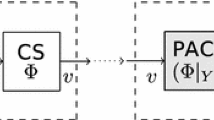Abstract
A composite signal is generally composed of multiple signals with various frequencies and amplitudes. Fourier series expansion is one of the examples of such decomposition in sine and cosine components. The finding of coefficients value is a tedious job. Approximate decomposition of composite signal with greater accuracy is possible using optimization. In this paper, a genetic algorithm-based optimization is proposed for such decomposition. Genetic algorithm is devised to mimic the natural selection process of evolution and provides an elegant way to arrive at an optimal solution. The problem that is dealt with in this paper is to find the coefficients of a Fourier expansion for best fitting after iteration of multiple generations. Different combinations of various crossovers and mutations are implemented. The results of the different combinations are analysed with different selection techniques.





Similar content being viewed by others
References
Forrest S (1996) Genetic algorithms. ACM Comput Surveys (CSUR) 28(1):77–80
Whitley D (1994) A genetic algorithm tutorial. Stat Comput 4(2):65–85
Mathew TV (2012) Genetic algorithm. Report submitted at IIT Bombay
Torrecilla-Pinero F, Torrecilla-Pinero JA, Gómez-Pulido JA, Vega-Rodríguez MA, Sánchez-Pérez JM (2010) Parametric approximation of functions using genetic algorithms: an example with a logistic curve. In: International conference on numerical methods and applications. Springer, pp 313–320
Hauser JW, Purdy CN (2006) Designing a genetic algorithm for function approximation for embedded and asic applications. In: 2006 49th IEEE international midwest symposium on circuits and systems, IEEE, vol 2, pp 555–559
Mitra S, Mitra A, Kundu D (2011) Genetic algorithm and m-estimator based robust sequential estimation of parameters of nonlinear sinusoidal signals. Commun Nonlinear Sci Numer Simul 16(7):2796–2809
Gabis AB, Meraihi Y, Mirjalili S, Ramdane-Cherif A (2021) A comprehensive survey of sine cosine algorithm: variants and applications. Artif Intell Rev 1–72
Wu Z, Zhao C, Liu B (2020) Polygonal approximation based on coarse-grained parallel genetic algorithm. J Vis Commun Image Represent 71:102717
Jensen A, Rengarajan SR (2006) Genetic algorithm optimization of a traveling wave array of longitudinal slots in a rectangular waveguide. Appl Comput Electromagn Soc J 21(3):337
Baqais A (2016) Genetic algorithm for function approximation: an experimental investigation. Int J Artif Intell Appl (IJAIA) 7(3)
Salman M, Haq IU, Ahmad T, Ali H, Qamar A, Basit A, Khan M, Iqbal J (2020) Minimization of total harmonic distortions of cascaded h-bridge multilevel inverter by utilizing bio inspired ai algorithm. EURASIP J Wirel Commun Netw 2020(1):1–12
Yoshimoto F, Harada T, Yoshimoto Y (2003) Data fitting with a spline using a real-coded genetic algorithm. Comput Aided Des 35(8):751–760
Yao L, Sethares WA (1994) Nonlinear parameter estimation via the genetic algorithm. IEEE Trans Signal Process 42(4):927–935
Jiang C, Serrao P, Liu M, Cho C (2020) An enhanced genetic algorithm for parameter estimation of sinusoidal signals. Appl Sci 10(15):5110
Deep K, Das KN (2008) Quadratic approximation based hybrid genetic algorithm for function optimization. Appl Math Comput 203(1):86–98
Lee Z-J (2008) A novel hybrid algorithm for function approximation. Expert Syst Appl 34(1):384–390
Vasconcelos J, Ramirez JA, Takahashi R, Saldanha R (2001) Improvements in genetic algorithms. IEEE Trans Magn 37(5):3414–3417
Bruderer E, Singh JV (1996) Organizational evolution, learning, and selection: a genetic-algorithm-based model. Acad Manage J 39(5):1322–1349
Katoch S, Chauhan SS, Kumar V (2021) A review on genetic algorithm: past, present, and future. Multimed Tools Appl 80(5):8091–8126
Wang Q (1997) Using genetic algorithms to optimise model parameters. Environ Modell Softw 12(1):27–34
McCall J (2005) Genetic algorithms for modelling and optimisation. J Comput Appl Math 184(1):205–222
Alajmi A, Wright J (2014) Selecting the most efficient genetic algorithm sets in solving unconstrained building optimization problem. Int J Sustain Built Environ 3(1):18–26
Hwang S-F, He R-S (2006) Improving real-parameter genetic algorithm with simulated annealing for engineering problems. Adv Eng Softw 37(6):406–418
Wright AH (1991) Genetic algorithms for real parameter optimization. In: Foundations of genetic algorithms, vol 1. Elsevier, pp 205–218
Smith J, Fogarty TC (1996) Self adaptation of mutation rates in a steady state genetic algorithm. In: Proceedings of IEEE international conference on evolutionary computation. IEEE, pp 318–323
Piszcz A, Soule T (2006) Genetic programming: analysis of optimal mutation rates in a problem with varying difficulty. In: FLAIRS conference, pp 451–456
Author information
Authors and Affiliations
Corresponding author
Rights and permissions
About this article
Cite this article
Pachuau, J.L., Kashyap, P., Kumar, A. et al. Segmentation of composite signal into harmonic Fourier expansion using genetic algorithm. Int. j. inf. tecnol. 14, 3507–3515 (2022). https://doi.org/10.1007/s41870-022-00944-7
Received:
Accepted:
Published:
Issue Date:
DOI: https://doi.org/10.1007/s41870-022-00944-7




